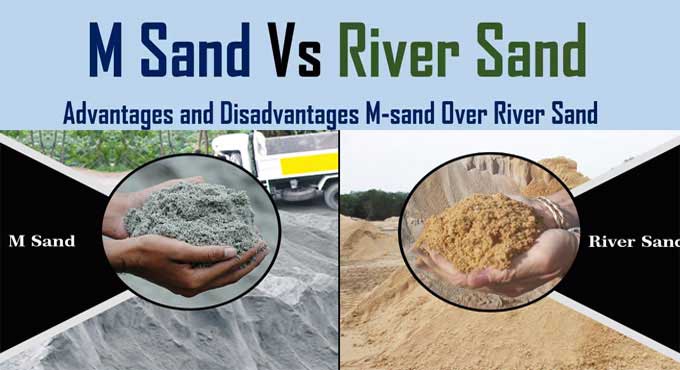NEWS | SOFTWARE | SHEET
Taking a closer look at the differences between M Sand and River Sand
Sand enhances the aesthetic appeal of a space by adding texture and visual appeal. The most important qualities of sand are that it is often pure, readily available, and economically intelligent. Keeping play areas safe for children can be achieved by building children's sandpits. As well as being very cheap, it is also very convenient.
Define Sand: In the construction industry, sand plays a very important role. From the foundation to the finishing works like plastering, sand is used everywhere in the construction process.
As a result of sand, concrete, mortar, asphalt, and cement are able to provide strength, bulk, and stability.
Define M Sand: Basically, M Sand, also known as Manufacturer Sand, is crushed rock or granite used in cement and concrete since it's a natural sand substitute. A wide range of physical and mineralogical differences distinguish M sand from natural river sand.
Define River Sand: Normally, the riverbeds or riverbanks contain R Sand, also known as River sand naturally. River sand is widely used in construction and is readily available in the market. In addition to the increased trust in infrastructure, river sand is being used more in the construction industry, and the demand for river sand continues to grow.
| Serial No | M Sand | River Sand |
| 1 | A factory makes M Sand. | There is a natural supply of this along river banks. |
| 2. | Sand from a quarry is used to manufacture M sand. A quarry or factory produces it by crushing rocks or quarry stones into sand size particles. | Usually extracted from riverbanks or riverbeds, this substance is naturally available. |
| 3. | M sand has an angular and cubical shape with a rough texture, making it better for concrete. | Unlike artificial sand, natural sand has a smooth surface and a rounded shape. |
| 4. | There is no moisture in the M Sand. | Particles generally contain moisture between them. Thus, concrete mix design and concrete quality assumptions are affected. |
| 5. | RCC and brick and block projects benefit greatly from this sand. | Brick and block work are also recommended to be built with river sand. |
| 6. | Compared to natural sand, M sand causes less environmental damage. | There is no benefit to the environment from using this river sand. Water in rivers gets dried up as a result of it reducing the groundwater level. |
| 7. | The amount of adulteration has decreased. | Due to acute shortages, there is a high likelihood of adulteration. It is common in coastal areas for natural sand to be adulterated with sea sand. |
| 8. | The price of M sand is about Rs 900 per ton. It is estimated that the price of M Sand in India ranges from Rs. 35 to Rs. 45 per cubic foot. | The price of river sand is near about Rs 480 per ton. River sand price ranges from Rs 60 to 80 per cubic foot in India. |
| 9. | Depending on the parent rock, M sand has a specific gravity of approximately 2.73. | According to rocks in the catchment area, river sand has a specific gravity of approximately 2.65. |
| 10. | A dry density of 1.75 kg/m3 is observed for M sand. | The density of naturally occurring sand is 1.44 kg/m3. |
Applications of Sand
- Among the many uses of sand, we can find aquariums, fringing reefs, beaches, and artificial coral reefs.
- Watermelon, peaches, peanuts, and other fruits and vegetables grow well in sandy soil.
- Moreover, mason jars can be filled with sand and tea lights to light up a passageway, which is another inexpensive way to brighten up a walkway.
- To prevent flare-ups around charcoal grills, we could use a small screw of sand.
- Using a little sand with warm soapy water, you can clean a narrow neck by mixing it with the water and putting it in the container. The use of sand can stabilize items that need proper repairing. By burying the broken pieces underneath sand grains, you can keep the elements together while gluing them.
- During icy or snowy conditions, the uses of sand helps improve the resistance, which in turn helps improve traffic safety.
By mixing two cups of paint with a cup of sand, we can make a sand mix that will hold your painting or wall art in place. The sand that is used to make sandpaper is polished into paper by polishing it.
To get more clear ideas, go through the following exclusive construction video tutorial.
Lecturer: Civil Engineers
The frameworks used in the casting process can be constructed by mixing sand with clay dams to hoist the metal. Industrial sand or M Sand can make glass, such as foundry sand and abrasive sand.
Recommended Articles:
Advantages of Sand Filling in Footing


